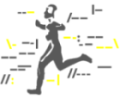





Search | Sitemap | Navigation |  |
|
||||||||||||||||||||||||||
|
||||||||||||||||||||||||||
|
||||||||||||||||||||||||||
|
| SM Musgrave |
Kurt W. Mueller

Kurt W. Mueller, Migraine, handcolored photocopy, 1991. © 2005 Kurt W. Mueller (www.seurat.art.udel.edu/Galleries/bookarts/Bookarts1.html, August 29, 2002)
"A duplicate copy of the piece entitled 'Migraine' hangs on the wall inside my office. An office occupied in my present capacity as Executive Vice President of Mueller & Wister, Inc., a strategic communications agency in which I am a present owner and managing partner.
The piece, 'Migraine' was hung in my office to serve as a continual reminder of the pain and unmerciful torture unleashed upon the victims of this condition. It is a reminder of a deep, dark prison, one without bars and yet one from which we cannot escape. This prison is one that is 'owned' by the prisoner, one with a warden on which pleas for kindness fall on deaf ears, one that has no governor who can issue a stay of execution. This prison is one that others cannot see, smell, taste or touch. We are in solitary confinement in this place, alone in our suffering.
There are not enough pages, in all the world, to contain the text required to describe what a migraine experience is like. And yet the irony of the situation is that books and the written word are the very communication vehicles by which we, as people, primarily communicated up until less than 200 years ago. Therein is the oxymoron of this piece.
In the infamous statement, 'A picture says a thousand words', it seemed appropriate to use wholly visual materials and representations to tell the story, and a 'book' to be the communication vehicle by which the story is told.
The book itself is comprised of the historic essentials: a cover, a spine, and main contents that are contained within the covers themselves. This book, however, tells its entire story without ever being opened. In fact, the story is made that much stronger, through the inability to open the book.
The colored-pencil illustration on the cover of the book represents a visual presentation of what pain feels like. The anguish, distortion, and unnatural depiction of the face describes to the viewer the enormous stress and distortion felt by the sufferer. Black, blue and purple were the primary colors of choice and were applied to give the face a bruised, gothic, cadaver look that represents the despair, agony, and deathlike feeling overcoming the victim during the episode. Soft lines and a vignette were applied to the face as an indicator of time, or the lack thereof, that there is no beginning or end to the episode and that the pain is fluid and will ebb and flow as 'it' sees fit, unconstrained by the concept of time.
Clear caulk was applied to the colored-pencil to provide a 3-dimensional relief to the face and present it as a dimensional person afflicted by the condition. Fish hooks were then hooked within the caulk and pulled back to further pull and stretch the already distorted face into X, Y and Z dimensions, giving this sufferer the ability to become 'real' by existing within the viewers' space. In some cases, the tension on the lines to which the hooks are connected, created tears in the caulk, which created a perfect symbolic representation of how the pain associated with a migraine tears the sufferer apart.
The last element of the piece is the barbed wire into which the book is entombed. The wire is weathered, old and rusted, symbolizing that this is a prison in which the victim has been confined for a long period of time. The book is imprisoned within the barbed wire, the victim able to look out into the world, but not able to escape. Attempting to open the book and unlock the clasp on this virtual cell would result in additional pain and suffering, thereby quickly discouraging anyone from attempting such an ill-fated effort.
As I turn off the lights in my office each day and head home for the evening, the haunting stare of that nameless face, imprisoned forever in time, cries silently in the night, reminding me on my journey home of the place I once was."
(Email to Klaus Podoll, October 9, 2002)
| Kurt W. Mueller is a 1991 graduate of the University of Delaware Visual Communications program who currently works as Executive Vice President of Mueller & Wister, Inc., a company with the vision of integrating strategy, traditional media and e-media. The artist's final degree work "Migraine" was displayed in the show "Book Arts 1982-1997", Department of Art Gallery, University of Delaware, January 12-30, 1998, an exhibition featuring a selection of artists' books created by students of the course "Book Arts", offered during the past 15 years during winter sessions by Professor Martha L. Carothers, Chair of the Department of Art and Coordinator of Graphic Design at the University of Delaware. |
Author: Klaus Podoll
Last modification of this page: Monday March 28. 2005
| SM Musgrave |
 Top of the page
Top of the page| · | News |
| · | Medical Professionals |
| · | Medical Studies |
Copyright © 2005 Migraine Aura Foundation, All rights reserved. Last modification of this site: August 25, 2006
Thanks to: RAFFELT MEDIENDESIGN and GNU software | webmaster@migraine-aura.org
http://migraine-aura.org/EN/Kurt_W_Mueller.html


